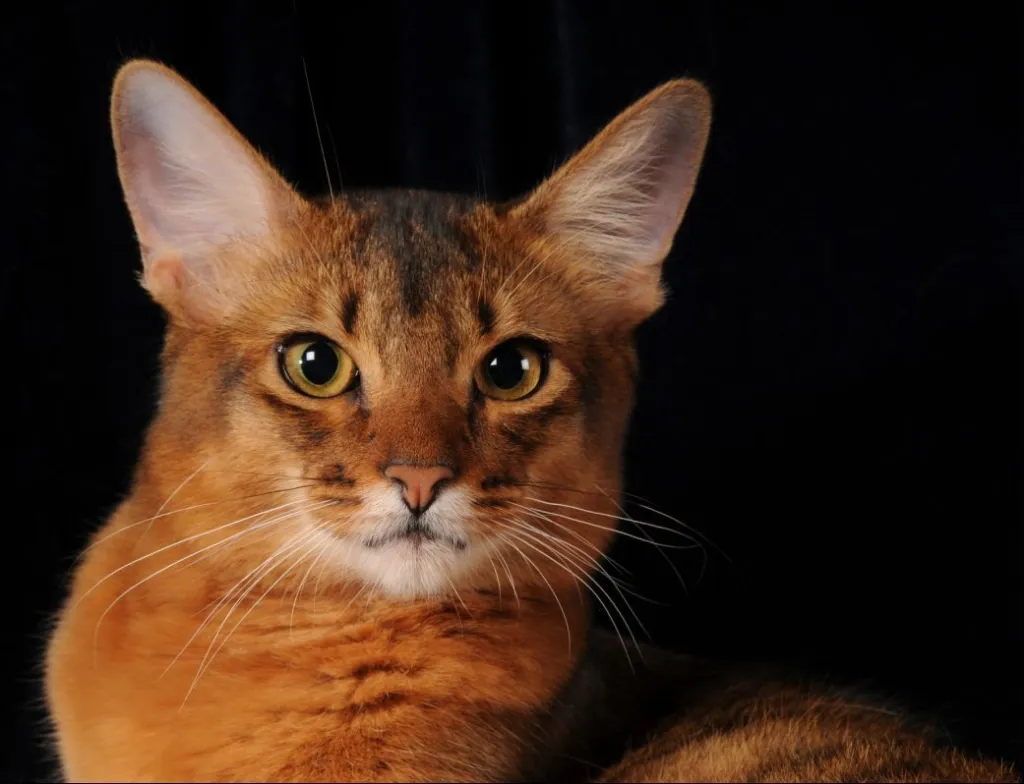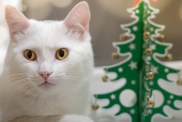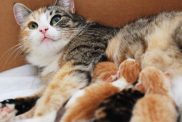Somali cats, with their long, luxurious fur and cute bushy tails, are a breed that exudes beauty and grace. Known for looking like a fox with a plush coat, these feline beauties are charming. Originating from the Abyssinian cat breed, Somali cats have semi-longhair coats, which come in a wide array of colors. Their coats feature a mix of vibrant shades, creating a warm and friendly appearance.
Beyond their physical allure, Somali cats have a playful and intelligent nature. Highly active and agile, these cats love playing and can be found gracefully leaping from perch to perch with apparent ease. Their curious nature make them excellent pets for those who appreciate a cat that keeps them on their toes.
When considering a Somali, it’s advisable to prioritize adopting a cat or kitten from rescue organizations or shelters to provide a loving home to a cat in need. However, if you decide to purchase a Somali kitten, it’s crucial to choose a reputable breeder. Conduct thorough research to ensure that the breeder follows ethical practices and prioritizes the well-being of their cats. Reputable Somali breeders prioritize the health and temperament of their cats, conduct necessary health screenings, and provide a nurturing environment for the kitties. This active approach ensures that you bring home a healthy and happy kitty while discouraging unethical breeding practices.
Quick Facts
- Origin: United States
- Size: Medium
- Breed Group: Longhair
- Lifespan: 12-18 years
- Coat: Medium-long, silky, and ticked, with a variety of colors, including ruddy, sorrel, and blue
- Temperament: Intelligent, playful, and loving
- Exercise Needs: High
- Training: Easy to train
- Grooming: Weekly brushing
- Health: Generally healthy, but can be prone to certain genetic health conditions, such as progressive retinal atrophy (PRA) and feline hypertrophic cardiomyopathy (HCM)
- Errol is an Instagram-famous Somali cat, who entertains his 100k+ audience with his cuteness.
- United States breeder Evelyn Mague is credited with naming the longhaired Abyssinians Somalis, which eventually led to the CFA recognizing Somalis as a separate breed.
- They are not actually from Somalia. The name is a nod to its relation to the Abyssinian.
- Some Somali cats can hold items in their paws.
Somali Pictures
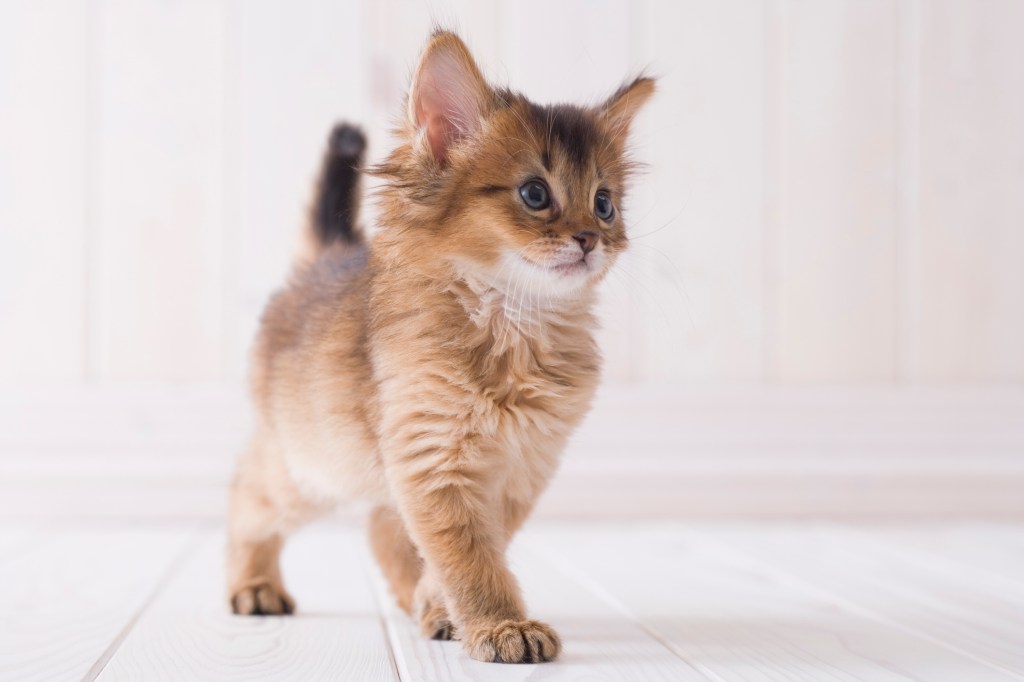
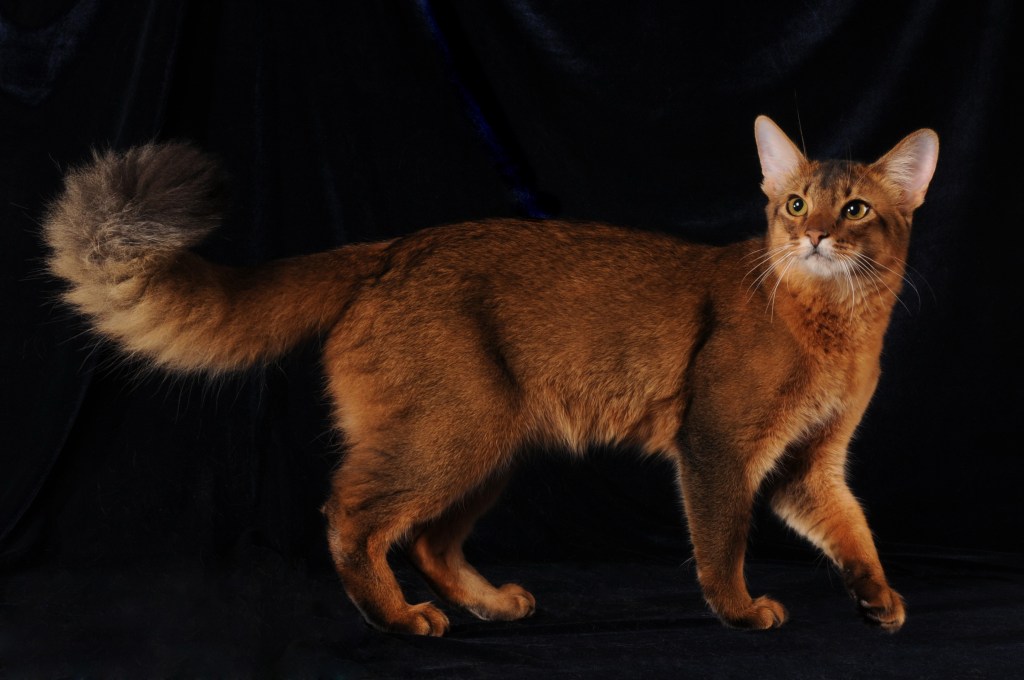
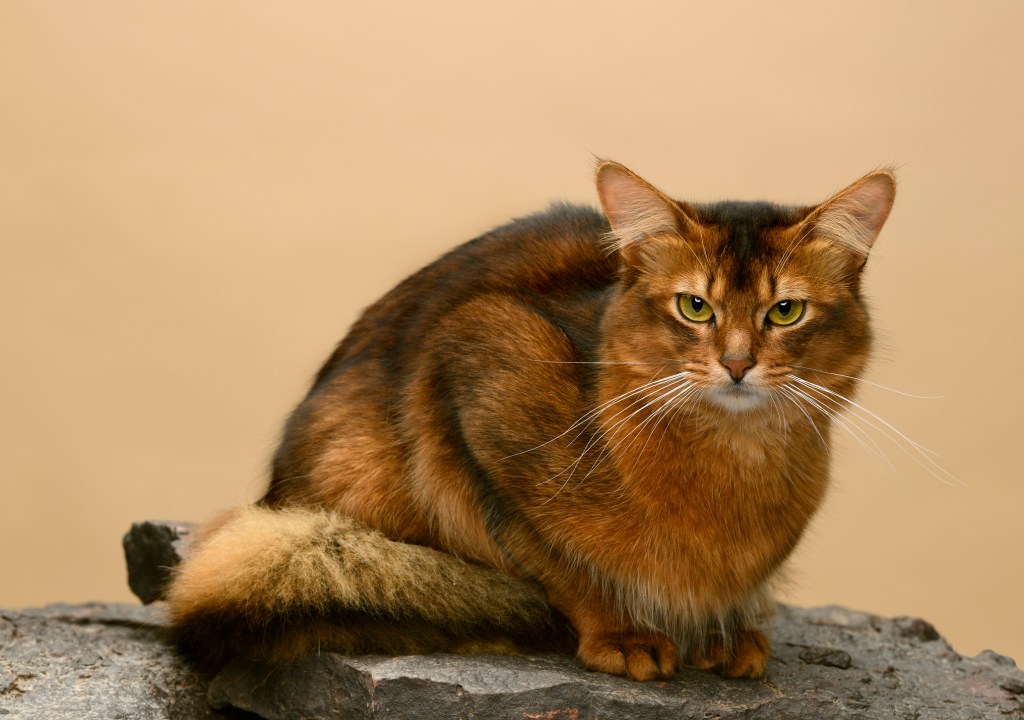
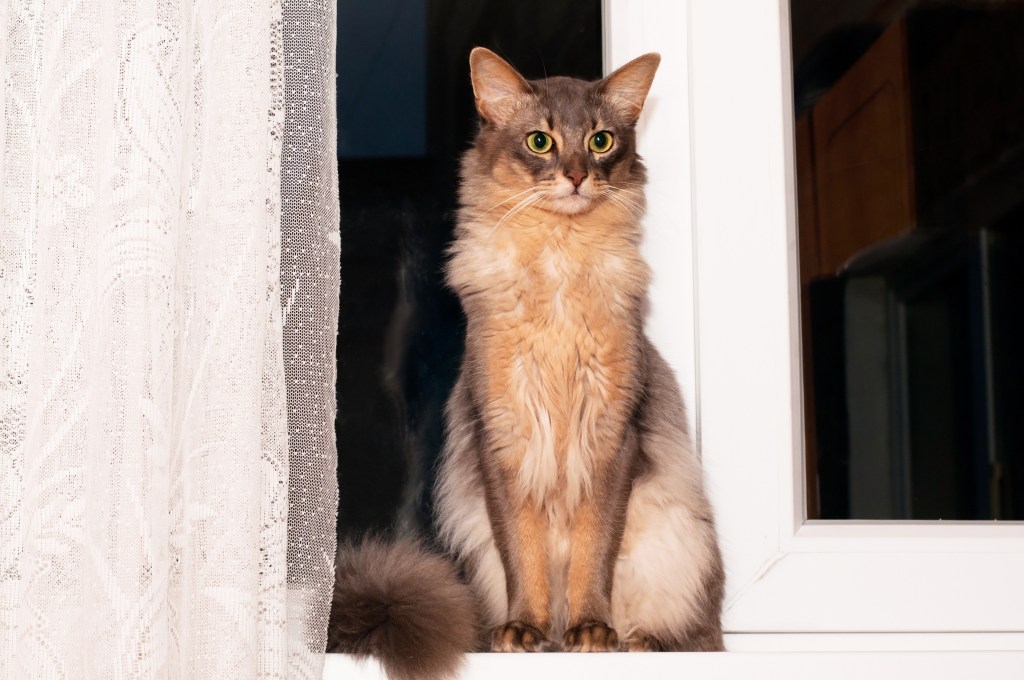
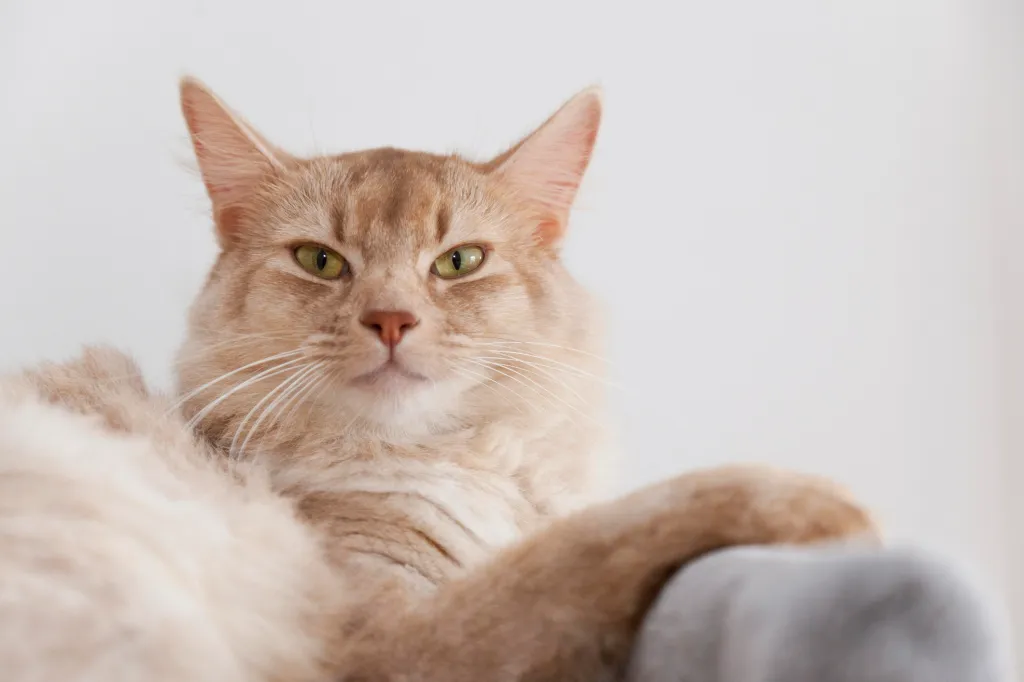
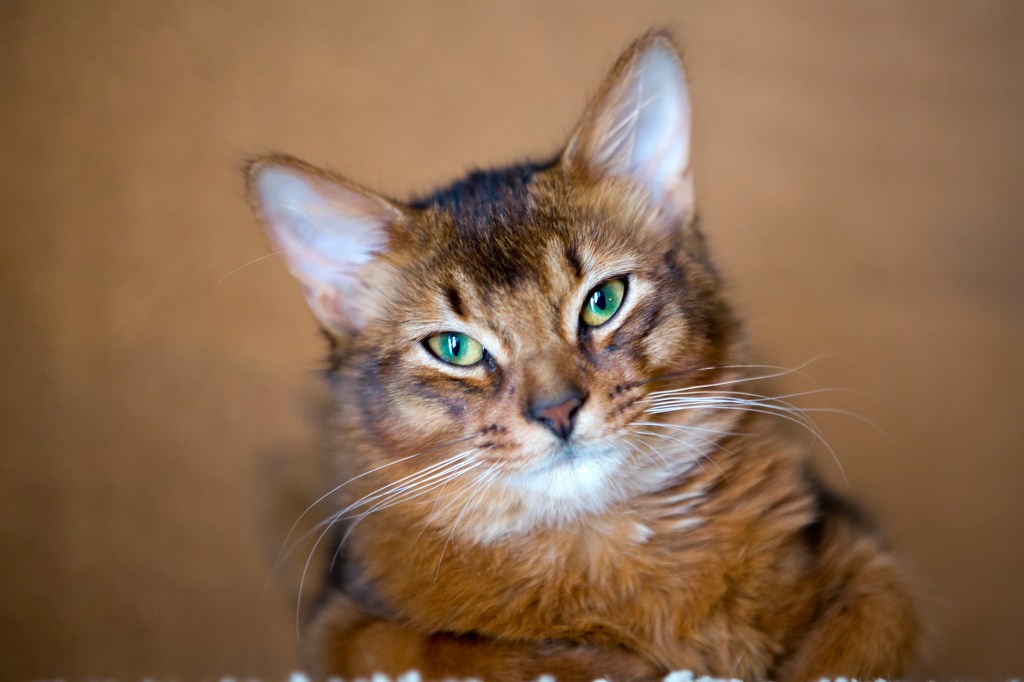
-
Affectionate with Family
Some cat breeds are typically independent and aloof, even if they’ve been raised by the same person since kittenhood; others bond closely to one person and are indifferent to everyone else; and some shower the whole family with affection. Breed isn’t the only factor that goes into affection levels; cats who were raised inside a home with people around feel more comfortable with humans and bond more easily.

See Cats Less Affectionate with Family -
Amount of Shedding
If you’re going to share your home with a cat, you’ll need to deal with some level of cat hair on your clothes and in your house. However, shedding does vary among the breeds. If you’re a neatnik, you’ll need to either pick a low-shedding breed or relax your standards. This furniture cover can make it easier to clean up cat hair and keep it off your sofa!
-
General Health
Due to poor breeding practices, some breeds are prone to certain genetic health problems. This doesn’t mean that every cat of that breed will develop those diseases; it just means that they’re at an increased risk. If you’re looking only for purebred cats or kittens, it’s a good idea to find out which genetic illnesses are common to the breed you’re interested in.
-
Potential for Playfulness
Some cats are perpetual kittens—full of energy and mischief—while others are more serious and sedate. Although a playful kitten sounds endearing, consider how many games of chase the mouse-toy you want to play each day, and whether you have kids or other animals who can stand in as playmates. A classic wand cat toy like this one is perfect for playful felines!
-
Tendency to Vocalize
Some breeds sound off more often than others with meows, yowls, and chattering. When choosing a breed, think about how the cat vocalizes and how often. If constant “conversation” drives you crazy, consider a kitty less likely to chat.
-
Kid-Friendly
Being tolerant of children, sturdy enough to handle the heavy-handed pets and hugs they can dish out, and having a nonchalant attitude toward running, screaming youngsters are all traits that make a kid-friendly cat. Our ratings are generalizations, and they’re not a guarantee of how any breed or individual cat will behave; cats from any breed can be good with children based on their past experiences and personality.
-
Friendly Toward Strangers
Stranger-friendly cats will greet guests with a curious glance or a playful approach; others are shy or indifferent, perhaps even hiding under furniture or skedaddling to another room. However, no matter what the breed, a cat who was exposed to lots of different types, ages, sizes, and shapes of people as a kitten will respond better to strangers as an adult.
-
Easy to Groom
Some breeds require very little in the way of grooming; others require regular brushing to stay clean and healthy. Consider whether you have the time and patience for a cat who needs daily brushing. You should definitely pick up this awesome de-shedding tool for cats of any hair length!
-
Intelligence
Some cat breeds are reputed to be smarter than others. But all cats, if deprived the mental stimulation they need, will make their own busy work. Interactive cat toys are a good way to give a cat a brain workout and keep them out of mischief. This scratcher cat toy can keep your smart kitty busy even when you’re not home!
-
Pet Friendly
Friendliness toward other household animals and friendliness toward humans are two completely different things. Some cats are more likely than others to be accepting of other pets in the home.
Somali History
Showing cats was all the rage in the late Victorian era. One of the unusual breeds exhibited at the Crystal Palace Cat Show in 1871 was an Abyssinian—“captured in the late Abyssinian War”—who took third place. The report on the cat show, published in the January 27, 1872, issue of Harper’s Weekly, was the first known mention in print of the breed. Unfortunately, no records exist regarding the cats’ origins, although myths and speculation abound, including claims that it was the cat of the pharaohs, and that it was created in Britain by crossing silver and brown tabbies with cats that had “ticked” coats.
Today, genetic evidence suggests that the cats came from Indian Ocean coastal regions and parts of Southeast Asia. British and Dutch traders may well have brought the cats from ports such as Calcutta, India, or the islands of Indonesia. A taxidermied specimen of a ruddy ticked cat exhibited in the 1830s at the Leiden Zoological Museum in The Netherlands, where he was labeled “Patrie, domestica India,” gives creedence to that theory.
The cats were probably given the name Abyssinian because Zula, the cat exhibited at the Crystal Palace, was said to have been imported from Abyssinia (now Ethiopia). Early pedigrees show crosses to non-Abyssinian cats, which may explain the introduction of new coat colors and the gene for long hair.
Enter the Somali. This longhaired variety of the Abyssinian was first noted in the early 20th century and probably came about when breeders introduced longhaired cats into their breeding programs to augment their stock—especially after World War II, when Abys were few and far between—but they weren’t developed as a breed in their own right until the 1960s and 1970s. They were given the name Somali as a nod to that country’s geographic status as the next door neighbor to Ethiopia (formerly known as Abyssinia).
Somali Size
This is a medium-size cat weighing 6 to 10 pounds.
Somali Personality
Like his sibling the Abyssinian, the Somali lives life to the fullest. He climbs higher, jumps farther, plays harder. Nothing escapes the notice of this highly intelligent and inquisitive cat, a quality that makes life with him both endlessly entertaining and continuously challenging. Staying a step ahead of a Somali, or even just keeping pace with him, requires the fancy footwork of a Fred Astaire, the brainpower of an Einstein and a sense of humor that never stops. You never know what he’ll get into next, although you can assume that if you have something or are doing something, your Somali will want to investigate it closely.
Sometimes it may seem as if the Somali never sleeps. He is ever in motion, jumping up in the window to look at birds or squirrels, leaping on top of the refrigerator to supervise meal preparation, perching on your desk to watch your fingers move over the keyboard and then swiping at them so you’ll pay attention to him instead. This is a playful, persistent cat who adores being the center of attention and will do anything to achieve and maintain that status.
The Somali loves to play, so plan on making or purchasing a variety of toys to keep him occupied. Ping-Pong balls, bottle caps, wadded-up pieces of paper, puzzle toys and teasers such as big peacock feathers will all amuse this busy and brainy cat. Teach him to retrieve at your peril. Once you start, he won’t let you stop. He learns tricks quickly and many Abys enjoy running a feline agility course.
A love of heights is a signal trait of the Somali. He likes to be as high up as possible and will appreciate having one or more ceiling-height cat trees. When those aren’t available, he is perfectly capable of making his way to the uppermost point of any room. Fortunately, he is naturally graceful and rarely breaks items unless it is simply out of curiosity. Somalis are adaptable throughout their lives and fit well into any home where they are loved and given plenty of attention.
In a home where people are at work or school during the day, the Somali does best with a companion, ideally another Somali or Aby, who can match his activity level. If left to his own devices, the Somali may well dismantle the house in his search for something interesting to do. Beware! The Somali can be addictive. Once you’ve had one, you may find that no other cat will do.
Somali Health
Both pedigreed cats and mixed-breed cats have varying incidences of health problems that may be genetic in nature. Problems that may affect the Somali include the following:
- Periodontal Disease: Periodontal disease in cats is a common and potentially serious dental condition that affects the tissues surrounding the teeth. It is characterized by inflammation and infection of the gums, often leading to dental problems that can impact a cat’s overall health.
- Hyperesthesia Syndrome: This is a neurological problem that can cause cats to excessively groom themselves, leading to hair loss, and to act frantically, especially when they are touched or petted.
- Patellar Luxation: This is a hereditary dislocation of the kneecap that can range from mild to severe. Severe cases can be alleviated with surgery.
- Progressive Retinal Atrophy: Progressive Retinal Atrophy (PRA) is a group of genetic disorders that affect the retina in both humans and animals, including cats. The condition leads to the degeneration of the retina over time, ultimately resulting in vision impairment or blindness.
- Pyruvate Kinase Deficiency (PKD): Pyruvate Kinase Deficiency (PKD) is a hereditary disorder that affects the metabolism of red blood cells in cats. It is an enzyme deficiency that impairs the ability of red blood cells to generate energy, leading to various health issues.
- Renal Amyloidosis: This is a heritable disease that occurs when a type of protein called amyloid is deposited in body organs, primarily the kidneys in Abyssinians. It eventually leads to kidney failure.
Somali Care
The medium length coat of the Somali needs a moderate amount of grooming. Comb the coat once or twice a week with a stainless steel comb to remove dead hair, prevent or remove tangles, and distribute skin oils. In the spring, when the cat is shedding his winter coat, you may need to comb him daily. A bath when the cat is shedding will help to remove excess hair more quickly. Check the tail for bits of poop stuck to the fur and clean it off with a baby wipe.
Brush the teeth to prevent periodontal disease. Daily dental hygiene is best, but weekly brushing is better than nothing. Trim the nails every couple of weeks. Wipe the corners of the eyes with a soft, damp cloth to remove any discharge. Use a separate area of the cloth for each eye so you don’t run the risk of spreading any infection.
Check the ears weekly. If they look dirty, wipe them out with a cotton ball or soft damp cloth moistened with a 50-50 mixture of cider vinegar and warm water. Avoid using cotton swabs, which can damage the interior of the ear.
It’s a good idea to keep a Somali as an indoor-only cat to protect him from diseases spread by other cats, attacks by dogs or coyotes, and the other dangers that face cats who go outdoors, such as being hit by a car. Somalis who go outdoors also run the risk of being stolen by someone who would like to have such a beautiful cat without paying for it.
Somali Coat Color And Grooming
Except for the additional length, the Somali has the same ticked coat as the Abyssinian. A ticked coat has alternating light and dark bands of color on each hair shaft. The Somali’s ticking may be slower to develop than that of the Aby.
Everything about him suggests his lively, attentive nature. The Somali has a slightly rounded wedge-shaped head topped with large, broad ears, the better to hear you with. Large, almond-shaped eyes of gold or green express interest in everything they see. On the face, dark lines may extend from the eyes and brows.
The muscular body is graceful and athletic. It falls into a middle ground between the stocky, or cobby, body of a breed such as the Persian and the long, svelte body of the Oriental breeds such as the Siamese. The body is supported by slim, fine-boned legs atop small, oval, compact paws. Somalis are often said to look as if they are walking on tip-toe. Swishing behind them is a full brush, or tail, thick at the base and slightly tapering at the end. Its bands of color give the Somali’s coat a warm, glowing appearance.
To the touch, the medium-length hair is soft and silky with a fine texture. The Somali stands out from the Aby for the ruff around his neck and the “breeches” on his legs, which give him a more full-coated appearance than the Aby. Horizontal tufts of fur adorn the inner ears.
The coat comes in four main colors: ruddy brown, more artistically described as burnt sienna and ticked with darker brown or black, with tile-red nose leather and black or brown paw pads; red (sometimes called sorrel), a cinnamon shade ticked with chocolate-brown, with pink nose leather and paw pads; blue, a warm beige ticked with various shades of slate blue, with nose leather described as old rose and paw pads as mauve; and fawn, a warm rose-beige ticked with light cocoa-brown, with salmon-colored nose leather and pink paw pads. Some associations permit additional colors, including chocolate, lilac, and various silver tones.
Children And Other Pets
The active and social Somali is a perfect choice for families with children and cat-friendly dogs. He will play fetch as well as any retriever, learns tricks easily and loves the attention he receives from children who treat him politely and with respect. He’s smart enough to get out of the way of toddlers but loves school-age children because they are a match for his energy level and curiosity.
Nothing scares him, certainly not dogs, and he will happily make friends with them if they don’t give him any trouble. Somalis have also been known to get along with large parrots, ferrets and other animals. Always introduce any pets, even other cats, slowly and in a controlled setting.
Somali Rescue Groups
More Info For You
If you’re also looking for a dog, check out DogTime’s dog breed page!
